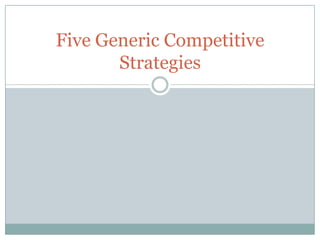Five generic competitive strategies
•Download as PPTX, PDF•
8 likes•5,390 views
This document outlines five generic competitive strategies: low cost, differentiation, best cost provider, focused low cost, and focused differentiation. It discusses when each strategy is most applicable, how to implement each one, and potential downsides. The strategies range from aiming for the broadest customer base with an overall low cost approach, to targeting a niche segment with specialized differentiation or low costs. Implementing the strategies successfully requires controlling costs, understanding customer needs, and preventing competitors from copying the approach.
Report
Share
Report
Share

Recommended
Recommended
More Related Content
What's hot
What's hot (20)
Generic competitive strategies-STRATEGIC MANAGEMENT

Generic competitive strategies-STRATEGIC MANAGEMENT
What is a Strategy? Michael Porter - Harvard Business Review

What is a Strategy? Michael Porter - Harvard Business Review
Viewers also liked
Viewers also liked (6)
Similar to Five generic competitive strategies
Similar to Five generic competitive strategies (20)
More from dragon888
More from dragon888 (8)
Intercultural communication saudi arabia, japan and brazil

Intercultural communication saudi arabia, japan and brazil
Five generic competitive strategies
- 1. Five Generic Competitive Strategies
- 2. Type of advantage sought Low costDifferentiation Broad differentiation Overall low-cost provider Broad range of buyers Market Target Best-cost provider Focused differentiation Focused low-cost Narrow range of buyers
- 3. How to compete Low cost provider Obsessively control costs Closely examine the value chain Broad differentiation Buyers have diverse needs Buyers pay a premium for a good fit Best cost provider Need to create the perception of value compared to competitors
- 4. How to compete (continued) Low-cost niche Narrow band of price conscious customers Big enough and concentrated enough Differentiation niche High end customers High quality Customized, rare or exclusive products and services
- 5. When to go low-cost Heavy price competition Standardized product Hard to differentiate Consumers use product in similar ways Low switching costs for users Buyers have bargaining power Newcomers use pricing to get into the market
- 6. Downside to low-cost Heavy pricecutting can lead to losses Train consumers to expect ever lower prices Maybe easy for competitors to copy strategy New technology may give rivals a pricing edge Over focus on costs may mean; Failure to notice change in usage Failire to notice desire for additional benefits/ features Failure to respond to changes in price sensitivity equated to growing spending power
- 7. When to used differentiation Customers have diverse needs Firm has the ability to create diverse products Rivals unable or unwilling to use a differentiation strategy Rapid pace of design and technology change
- 8. Downside to differentiation Buyers may not care about the perceived benefits Firm may not be able to create the perception of value Competitors copy so no longer unique Differentiation obsession may lead to unacceptable costs Feature creep
- 9. When to be a best-cost provider Firm can provide a quality product at a relatively low cost Firm can provide a better performance at cost lower than rivals Firm can provide a higher level of customer service than rivals at no or low cost to customer
- 10. Downside of best-cost provider Danger of being stuck in the middle Low cost providers draw away the price conscious Focused differentiators draw away the more discerning
- 11. When to use a niche focus Segment not important for industry leaders Availability of relatively rare resources and skills Few rivals in the niche Customers perceive firm to be experts and / or have high credibility The niche is big enough to be profitable
- 12. Downside of niche focus Changes in technology and fashion may render product / service irrelevant Profits in the segment make it attractive to new rivals